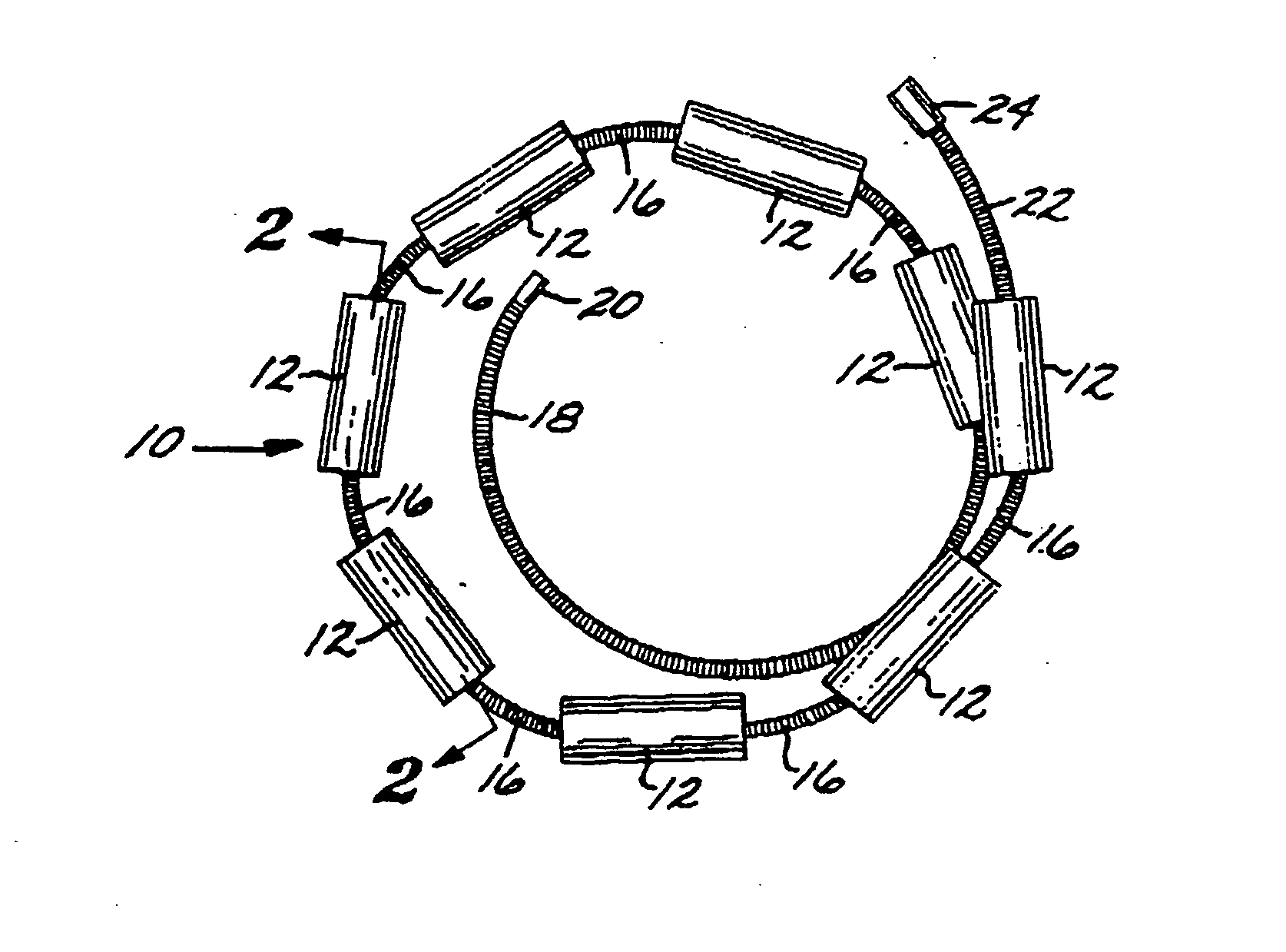Method of manufacturing expansile filamentous embolization devices
a filamentous embolization and filament technology, applied in the field of body cavity occlusion devices, can solve the problems of balloon rupture during inflation, difficult visualization, and difficult to retrieve or move after solidifying fluid sets, and achieve the effects of promoting effective embolization, excellent location control, and reducing the risk of vascular ruptur
- Summary
- Abstract
- Description
- Claims
- Application Information
AI Technical Summary
Benefits of technology
Problems solved by technology
Method used
Image
Examples
second embodiment
[0096] The Embolization Device: Second Preferred Embodiment. FIGS. 14 through 23 illustrate an embolization device in accordance with a second preferred embodiment of the present invention. Referring first to FIGS. 14 through 17, a device 100 in accordance with this second embodiment comprises an elongate, flexible, filamentous carrier 102 on which an expansile embolizing element 104 is non-releasably carried. The carrier 102 is preferably formed from a continuous length of hollow microcoil 106, made from a suitable metal such as platinum, gold, tungsten, or tantalum, or a metallic alloy, such as stainless steel or Nitinol. Of these materials, platinum and Nitinol are preferred. The microcoil is formed with tightly-packed coils, so that there is little or no spacing between adjacent coils. The carrier 102 may also include a filamentous core 108 extending axially through the microcoil 106. The core 108 is a thin metal wire, preferably made of a shape memory metal such as Nitinol. The...
third embodiment
[0115] The Embolization Device: Third Exemplary Embodiment and First Method for Making It: A third exemplary embodiment of a device 300 for occluding a body cavity is illustrated in FIGS. 32-35, and a first exemplary embodiment of a method for making the device 300 is illustrated in FIGS. 24-31.
[0116] As shown in FIG. 32, the embolization device 300 comprises an elongated, filamentous carrier 302, and an embolizing element comprising a coaxial member 304 of an expansile, hydrophilic polymer, or hydrogel, described in detail above, encapsulating at least a portion of the length of the carrier.
[0117] Although the coaxial polymer embolizing member 304 is shown in the figures as having a substantially cylindrical shape, it should be understood that the member, and indeed, the carrier encapsulated within it, can have a wide variety of other cross-sectional shapes, e.g., polygonal, longitudinally grooved, and the like, depending on the particular application at hand.
[0118] The carrier 3...
fourth embodiment
[0126] The Embolization Device: Fourth Exemplary Embodiment and Second Method for Making It: A fourth exemplary embodiment of an embolization device 400 for occluding a body cavity is illustrated in FIGS. 39-42, and a second exemplary embodiment of a method for making the device 400 is illustrated in FIGS. 36-38.
[0127] As illustrated in FIGS. 39 and 41, respectively, two possible variants of the fourth exemplary embodiment of embolization device 400 both comprise, as in the case of the third exemplary embodiment 300 described above, an elongated, filamentous carrier 402, and a coaxial member 404 of an expansile, hydrophilic polymer, or hydrogel, encapsulating at least a portion of the length of the carrier. Further, in both variants, the carrier 402 may, like the third embodiment above, comprise either an elongated strand of a flexible, biocompatible material, e.g., platinum wire, or a flexible tube.
[0128] However, in contrast to the third embodiment of the device 300 above, in the...
PUM
| Property | Measurement | Unit |
|---|---|---|
| diameter | aaaaa | aaaaa |
| diameter | aaaaa | aaaaa |
| diameter | aaaaa | aaaaa |
Abstract
Description
Claims
Application Information
 Login to View More
Login to View More - R&D
- Intellectual Property
- Life Sciences
- Materials
- Tech Scout
- Unparalleled Data Quality
- Higher Quality Content
- 60% Fewer Hallucinations
Browse by: Latest US Patents, China's latest patents, Technical Efficacy Thesaurus, Application Domain, Technology Topic, Popular Technical Reports.
© 2025 PatSnap. All rights reserved.Legal|Privacy policy|Modern Slavery Act Transparency Statement|Sitemap|About US| Contact US: help@patsnap.com



